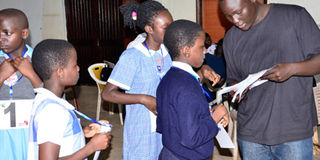Grouping students by ability may improve their performance

Students talking with a teacher as he examines their work. Grouping students according to their academic need, if done poorly, can affect the motivation of a child. FILE PHOTO
When Scovia Tumusiime went to visit her ten-year-old daughter at her school, she learnt – from other children – that the child had been placed in a class set aside for poor performers.
“I found a student at the gate and asked her if she knew my daughter. Surprisingly, another child standing nearby shouted, ‘You mean the one in P.5C, the class for the academic dwarfs?’”
Annoyed, Tumusiime demanded to know from her daughter’s teachers why she was paying huge amounts of money in school fees yet her daughter was categorised as an academic dwarf. “After she completed that academic year, I felt compelled to take my child to another school. I reasoned that keeping her in a class of academic dwarfs would torture her and worsen her performance.”
According to Deogratious Ssekanoni, the deputy head teacher of Seeta Junior School, separating learners according to their academic capabilities is debatable. “To some teachers, this is an opportunity give extra attention to students who take time to grasp ideas and concepts. However, most parents are against this grouping theory, because they think grading makes the child reluctant to learn and affects them psychologically.”
He also says, in his interaction with parents, some of them argue that streaming helps bright learners but not slow ones.
Tumusiime observes that grading lowers competition and motivation among pupils. “When two slow learners are put together, they may not have the motivation to do better. However, when in mixed ability, the exposure to a bright student will make slow learners struggle to perform better.”
Grading does have benefits
On the contrary, Barbra Kanyunyuzi, a teacher at Bright Star Primary School, says streaming is good because the slow learners are given more attention by the teacher.
“When learners of the same academic capability are put together, you can teach them depending on how fast they grasp. In a class of slow learners, you have to teach a concept, explain it several times in the simplest form until they understand. This will not happen if they are mixed with the fast learners because the latter understand quickly. As you move along, you will find that the slow learners are left behind.”
Shadrack Natamba, a lecturer at Kyambogo University, says streaming is good for learners as long as it aims at using appropriate teaching aids, methods and time so that they can compete fairly in the same exams or tests.
“Streaming should not be for the purpose of separating fast learners from average students. Instead of using chronological letters to name the streams, one can name them using colours or compass points so that the learners do not feel stratified.”
Natamba says the advantage with streaming is that there is no possibility of leaving anyone behind since the low ability class normally has fewer learners.
“Students are able to motivate each other since they have similar abilities and the teachers realise the learners individual needs. However, this can well be done by teachers who have properly been cautioned not to segregate children in terms of performance. Some teachers give more attention to bright students but this should not be the case because all children need equal attention.”
A case for ability grouping
Those who support ability grouping argue that without it, teachers are forced to teach only average students. This is because the quick and slow learners soon get bored.
The former get bored because of many repetitions the teacher has to make, while the latter get bored because they do not understand much of what the teacher is saying in the stipulated time that a class has to run. As such, brighter students learn more when they are placed with their peers. The reverse is true for students who have a slow learning ability.
However, to limit the psychological damage that grouping might cause a student, he or she must be advanced to another group once they have shown steady progress.
At the end of the day, both groups are learning the same lesson, just at different levels of complexity.
Take cautions
Margaret Tumusiime, a counselling psychologist at Girl Talk Uganda, a non-governmental organisation, says, “Streaming is a bad practice because students are psychologically tortured and demotivated.
It traumatises students and this inadvertently leads to bad performance. Teachers should not make the children believe that they cannot perform well, instead they should encourage them to take on bigger challenges.”



